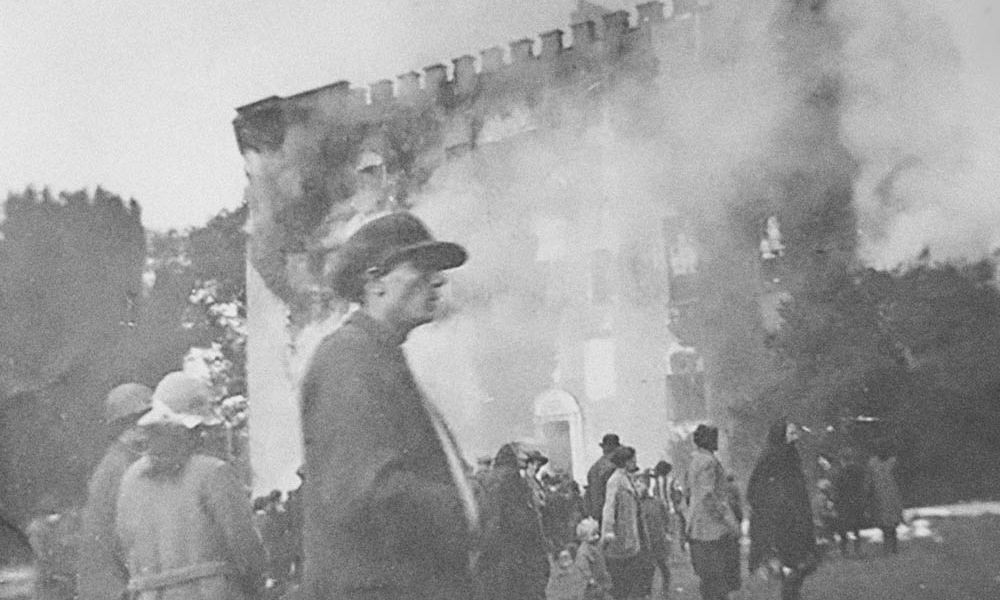A time of revolution: Macroom Castle, County Cork, August 1922. This is a rare image of an Irish country house in the midst of burning Photo in the author’s possession
The term “The Big House”—universally understood in Ireland and the subject of this absorbing new study by Terence Dooley, professor of history at Maynooth University and author of The Decline of the Big House in Ireland (2001)—would never be used of a merely large house.
The Big Houses were the homes of the Anglo-Irish landlord class. Some survive, but hundreds were destroyed by fire in 1920-22 during the fight for Irish independence from the United Kingdom of Great Britain and Ireland, and the fracturing civil war that followed the signing of the Anglo-Irish Treaty in 1921 (which established the Irish Free State and Northern Ireland, the latter remaining within the United Kingdom). From relatively modest Georgian country houses to some of the grandest ever built in Ireland, their broken gables silhouetted against rainy skies were ubiquitous in my childhood. One survived empty but reasonably intact to be offered as accommodation when my grandmother became headmistress in a small village: a practical woman, she chose instead a small cottage.
The traditional explanation for their loss was an orgy of patriotic arson, which saw their very architecture as colonial oppression. However, in this important reassessment, drawing on contemporary accounts, earlier regional studies and a wealth of recently released archive material, Dooley argues for a much closer look at the social and economic history of the previous 70 years. The land-hungry tenants of inviably small farms, despite earlier sales and breaking up of many estates, were a more potent driver, Dooley suggests; in some cases arsonists directly benefited from distribution of demesne lands.
The early part of the book has the dry feel of an expanded dissertation, heavy on footnotes, light on colour. Anyone not reasonably conversant with late 19th and early 20th-century English and Irish history may become lost among the names of politicians and public figures, but once the fires start the narrative heats up. By that time many houses had skeleton staff and massive backlogs of repairs, their debt-burdened owners already decamped to England. Looting inevitably followed the fires, with accounts of locals turning up with carts and prams to choose from contents piled on the lawns. Furniture from the grandest rooms was often spurned in favour of more useful beds from the servants’ quarters. Dooley points out that while few houses had full or up-to-date inventories, there were claims of blazing Rembrandts and Van Dycks, and of a solicitor in a small town whose walls were suddenly covered in fine paintings.
Some really were big houses: the book, poorly served by grimy reproductions of grainy black-and-white photographs, badly needs some decent plates to show their quality. Summerhill, a Palladian mansion in Meath, was regarded as the greatest loss in architectural terms, but Mitchelstown Castle in Cork, scene of a famous 1914 end-of-era garden party described in Elizabeth Bowen’s memoirs, was a monster. The largest Gothic revival castle in Ireland, built in 1823-25 for a reputed £100,000, it had 100ft towers, three libraries, and a dining room that could and did seat 100. The fire, fuelled by looted petrol and furniture piled high in the rooms, was seen for miles. The compensation claim, like many, rumbled on for decades, but it could never have been rebuilt: instead lorry loads of cut limestone were sold as salvage, and used to build a Cistercian monastery at Mount Melleray, County Waterford, an irony that might make a novelist blink.
• Terence Dooley, Burning the Big House: The Story of the Irish Country House in a Time of War and Revolution, Yale, 368pp, 63 b/w illustrations, £25/$35 (hb), published UK 8 March and US 19 April
• Maev Kennedy is a freelance arts and archaeology journalist and a regular contributor to The Art Newspaper

